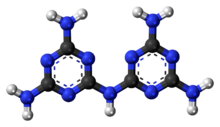Melam
Topic: Chemistry
 From HandWiki - Reading time: 1 min
From HandWiki - Reading time: 1 min

| |

| |
| Names | |
|---|---|
| IUPAC name
N2-(4,6-Diamino-1,3,5-triazin-2-yl)-1,3,5-triazine-2,4,6-triamine
| |
| Other names
A1,3,5-Triazine-2,4,6-triamine
| |
| Identifiers | |
3D model (JSmol)
|
|
| ChemSpider | |
| EC Number |
|
PubChem CID
|
|
| UNII | |
| |
| |
| Properties | |
| C6H9N11 | |
| Molar mass | 235.21 g/mol |
| Appearance | white powder |
| insoluble | |
| Solubility | slightly soluble in acids |
Except where otherwise noted, data are given for materials in their standard state (at 25 °C [77 °F], 100 kPa). | |
| Infobox references | |
Melam (N2-(4,6-diamino-1,3,5-triazin-2-yl)-1,3,5-triazine-2,4,6-triamine) is a condensation product of melamine.
Synthesis
Melam was discovered by Liebig in 1834 from the residue of heating ammonium thiocyanate.
Chemical property
In the presence of 30% ammonia, melam undergoes hydrolysis to form ammeline and melamine. It also reacts with concentrated nitric acid, producing cyanuric acid.
Upon heating, melam first loses ammonia to form melem, and then melon.
References
- B. Bann and S.A. Miller, "Melamines and derivatives of melamine", Chemical Reviews, vol.58, p131-172 (1958).
Licensed under CC BY-SA 3.0 | Source: https://handwiki.org/wiki/Chemistry:Melam7 views | Status: cached on October 07 2024 05:41:00↧ Download this article as ZWI file
 KSF
KSF